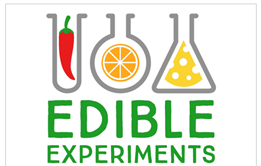Discover the importance of chemistry in everyday eating experiences
Edible experiments provide a wealth of ideas based on chemistry and food to engage learners and stimulate thinking about the relevance of chemistry.
Equipment
Apparatus
- Bin bags
- Plastic cups
- Plastic spoons (teaspoons, if possible)
- Labels
- Pens
Chemicals
- Citric acid
- Bicarbonate of soda
- Icing sugar
- Popping candy
Health, safety and technical notes
- Read our standard health and safety guidance here.
- Wear eye protection if desired.
- This experiment involves edible components, make sure allergen information is clearly displayed.
- For more information about citric acid, see CLEAPSS Hazcard HC036C
- Bicarbonate of soda, icing sugar, and popping candy are all low hazard.
Procedure
Sherbet
Invite your edible explorer to make their own sherbet. Make sure you have enough bicarbonate of soda, citric acid and icing sugar in clearly labelled cups before they start.
- What does sherbet taste like?
- What does it do in your mouth?
- Do you know what gas is given off?
- We’re using citric acid and bicarbonate of soda – do you know anything about these ingredients?
Ask them to place 1 level spoonful of bicarbonate of soda, 1 heaped spoonful of citric acid and 3 level spoonfuls of icing sugar into a clean plastic cup. Get them to mix it very well and ask them to try some.
Popping candy
Invite your edible explorer to try some popping candy, which you’ve sprinkled in the palm of their hand.
- What does it do when you put it on your tongue?
- What do you think is happening in your mouth?
- Do you know what gas is given off?
- How do you think it’s made?
- Have you tried baking with it – does it work when you put it in wet mixture? If not, why not?
- Will you pop if you eat too much?
They can eat the popping candy and their DIY sherbet whilst you explain.
What’s the chemistry?
Sherbet
There are many foods (and drinks) which are acidic. We use citric acid in this case, which is roughly pH 2 and found in citrus fruits. There aren’t many foods or drinks which are alkaline, but bicarbonate of soda is about pH 9.
citric acid + bicarbonate of soda → sodium citrate + water + carbon dioxide
Popping candy
Manufacturers melt sugar, lactose, water and colouring/flavouring mixture. Then, they blast this with about 600 pounds per square inch of carbon dioxide – that’s about 40 times greater than atmospheric pressure. Carbon dioxide gas is able to dissolve in the molten sugar mixture. As it cools and hardens, and the mixture breaks into tiny pieces. Because the sugar has been cooling, tiny bubbles of carbon dioxide are encapsulated inside. When the sugar melts on your tongue, the bubbles of gas are released, causing a popping sensation.
Notes
- Make sure you buy food-grade citric acid and bicarbonate of soda.
- Mix up the ratios, to create your own strength of sherbet.
- Always make sure you know the allergy advice.
- Popping candy is available in most supermarkets.
Downloads
Edible experiments: Sherbet and popping candy demo sheet
Handout | PDF, Size 0.27 mb
Additional information
All tasting activities should take place outside of science labs, and there should be careful checking for allergies in all participants.
Part of our Edible Experiments series.
Acknowledgements
This resource was produced by Dr Joanna Buckley, University of Sheffield. It is also hosted on the University of Sheffield website.
Copyright University of Sheffield.
Edible experiments

Discover the importance of chemistry in everyday eating experiences with this collection of edible experiments.
- 1
- 2
- 3
- 4
- 5
- 6
- 7
 Currently
reading
Currently
reading
Sherbet and popping candy
- 9
- 10
- 11
- 12
- 13
- 14













































No comments yet